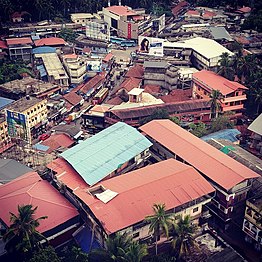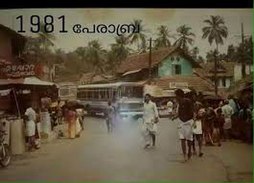Perambra

Perambra
പേരാമ്പ്ര periya ambara | |
|---|---|
Town | |
| Coordinates: 11°33′27″N 75°45′38″E / 11.5575°N 75.7605°E | |
| Country | |
| State | Kerala |
| District | Kozhikode |
| Area | |
• Total | 63.89 km2 (24.67 sq mi) |
| Population (2011) | |
• Total | 76,610 ( Perambra + Nochad + Koothali) |
| Languages | |
| • Official | Malayalam, English |
| Time zone | UTC+5:30 (IST) |
| PIN | 673 525 |
| Telephone code | 91 496 |
| ISO 3166 code | IN-KL |
| Vehicle registration | KL-77 |
| Website | www |
Perambra is a major town in Koyilandy taluk of Kozhikode district in North Malabar region of Kerala state, India.There is a high demand from people to allow Perambra as a Taluk and Municipality.It is one of the 140 assembly constituencies in Kerala, and one of the 12 block Panchayats in Kozhikode district. Perambra lies almost at the centre of the district.
Block Panchayat

The block has a population of 1,71,433; (86,019 males and 85414 females). The Perambra block has seven panchayats: Changaroth, Cheruvannur, Kayanna, Koothali, Chakkittapara, Nochad and Perambra.
Transportation

Perambra town connects to other parts of India through Koyilandy, kozhikode and Vadakara. The nearest airports are at Kannur and Kozhikode. The nearest railway station is at Koyiandy. The national highway no.66 passes through Koyilandy and the northern stretch connects to Mangalore, Goa and Mumbai. The southern stretch connects to Cochin and Trivandrum. The eastern National Highway No.54 going through Kuttiady connects to Mananthavady, Mysore and Bangalore.
Educational History
The social reform movements, missionary work, drinking places, and service of the ground clerk are all factors that contribute to the educational activities of the Perambra block in the early stages. A board school was established in Perambra as a result of the activities of the Basel Mission. Groundbreaking schools, mosques and monastic schools existed in Cheruvannur, Nochat, Kayanna, Koothali, Changaroth and Perambra. Growing up in the traditional tradition of indigenous medicine, astrology, carpentry, veterinary medicine, music and dance, informal education contributed to social development. As colonial education began to proliferate, informal and traditional education became a setback. The activities of the Malabar District Board have expanded and formal educational institutions have emerged. The oldest school on the block was the Muipotpol ALP School, established in 1860 at Muipotpot in Cheruvannur. During the period when the caste system was rampant, the Pancham schools, which were set up for the Harijans in the villages of Perambra and Cheruvannur, did not work for many social reasons. The lower castes have been admitted to public schools as part of the agitations against the caste system and practices of untouchability. The schools started from 1944 in the settlement area of Chakkitapara. Many prominent individuals on the block are educational work


Has made considerable contributions to it. Freedom fighter KT Kunhiraman Nair, Rev. Father C.J. Varkey, Dr. K.G.Adiyoti, K.T.Appanair, Saithalikutty Moulavi, and Chathan Vaidyar are some of them. Noted writer Avalla T. Kunhirama Kurup, poet and teacher Cheruvannur P Narayanan Nair, KR Kerala Varma and Kunhiraman Ezhuthachan were eminent teachers. There are 50 LP schools, 22 UP schools and 9 high schools in Block Panchayat. Established in 1975, CKGM Government College has facilities for undergraduate and postgraduate studies. Perambra High School has been upgraded from 1991 to Higher Secondary School.
History Of Perambra


The area which was formerly known as Payyarmalanadu, eventually became Perambra. In the Northern Songs, there are references to the Paayyormalanadu of Old Kurumbranadu. William Logan's Malabar Manual mentions that the territories under the Kurumbranadu, such as Cheruvannur, Meppayur, Perambra, Kayanna and Palleri were ruled by independent rulers called Payyarmala Nayanas. They had administrative ties to the Kurumbranad kings and the Zamorin. The rulers at that time were blessed by the kings, saying: "Pour by the jug, the sword, and the water on the sword, and kill and kill." The present day Perambra and the adjoining areas were owned by such feudal-landlord families. The land which had the right to kill and murder was held by the rulers and the guerrilla model, who led agitated guerrilla warfare by organizing agrarian revolts against the British imperialism, including the tax refusal. They, the Harijans and backward classes, have been subjected to vicious exploitation and oppression of the caste-landlord feudalism. Banathurillam, Vaniyam Math, Kadumadam, Maths of Kayanna and Koothalyi are the chefs of Kerala. Perambra is said to have belonged to the early Brahmin settlements such as large wings, ponds and temples. Koothali is no longer commonplace; Folks. It may have once been a place of frequent roosting and beauties. The art of the Koothu is being maintained by a minority. Koothu was the art of a small minority of upper-caste Hindus and upper classes. But on the other hand, the art of the common people was the folklore, the beatings and the like. It was the Harijans who became the martyr when the Cold War of Avinidu-Koothali Nayas turned into an open war. Mosquitoes continue to be a celebration of those heroic memories. "Somewhere round" and "copper" are examples. The Kariyathan-Kuttikathan-Chamundithirams were the rituals of the lower classes for indirect disgust with the feudal forces.
The rich carvings at Kalpathur still impress the historians. The story of the Ramayana is engraved on it. Researchers say that the Nochhat area is one of the oldest Jain temples in Kerala. By the 1920s, large numbers of migrant farmers began to migrate. Their contributions to the development of the Perambra and surrounding areas, and to the agricultural economy, are not small. They proceeded by grazing and spreading their fields. In the highlands, they cultivated chilli, coconut, coconut, coconut palm, tapioca and tapioca. He started rubber cultivation in the hilly areas, fighting the wild animals and malaria. They are also the ones who have expanded pepper farming. The Muslim traders who followed the traditions of forest resources, cliffs, and Arabian treasures that began to flow from the cliff, when Perambra began to grow from its early childhood. Small towns were popping up in the interior. Perambra is also known as a commercial center in the Kozhikode district along with Farok, Koyilandi and Vadakara. In 1932, the government acquired the entire land of Koothali Moopal Nair under the Attalakkadu Act, following the abolition of the heirship under the draconian law. The "Koothali Engine" which covers most parts of the old Kurumbranad extends to Wayanad. The thunderbolt of the agrarian agitation "Chatthal, Cheth Koothhali" emerged from this soil.
The strike began as part of the Grommore Food Campaign, when World War II began to rage on hunger, hoarding and hoarding throughout the country. One of the achievements of the Koothalli agitation is that Poonam agriculture has made Perambra a great contribution to the agricultural economy of Kerala. The blockbuster is associated with the name of VK Krishna Menon's sister who is a world famous. Brahmans, landlords, devaswam and kovilakas were the owners of the land. The natives of the land are not directly cultivated. It was customary for the cultivators to give a portion of the crop. As the natives of the society grew in size, so did the share of their crops. The basis of the caste-landlord-feudal economy lies in the enslavement and suffering of the vast majority of subordinates. The sounds of the nationalist movement and independence movement emerged in and around Perambra during the colonial period. The masses began to rally against the oppressions imposed by colonialism, the exploitation of imperialism, untouchability, superstition and Harijana oppression. The emergence of the nationalist movement has sparked a wave of nationalist movements such as the right to a bath, the right to walk in public, temple access, libraries, geriatric education, dispatch of Harijans to school, civil disobedience, salt satyagraha campaign, foreign garb, Hindi study and agrarian and labor movement. Since VV Giri's speech in 1939, Jayaprakash Narayanan too had attended a function at the Perambra UP School premises, nicknamed "Giri Maidanam". Vinobabhava came and set up a Bhudan village in Chakkitapara.
See also
- Nadapuram
- Thottilpalam
- Madappally
- Villiappally
- Memunda
- Iringal
- Mahe, Pondicherry
- Payyoli
- Thikkodi
- Orkkatteri


